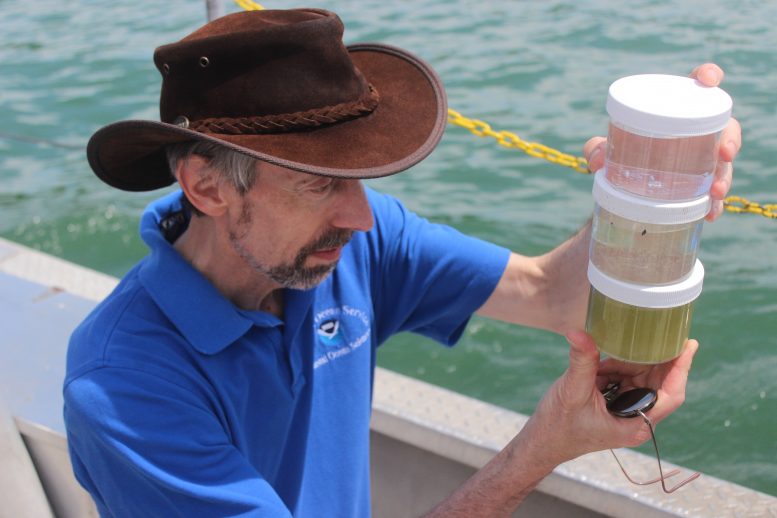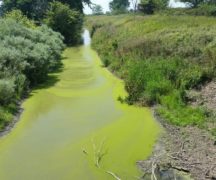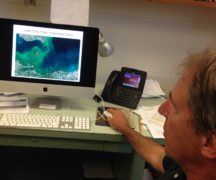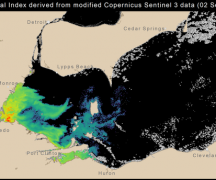By DAVID DUPONT
BG Independent News
Even in an age of satellites, vintage tools have their place in protecting the environment.
The research in harmful algal blooms in Lake Erie by scientists from state and government agencies and institutions of higher education is constantly evolving.
A new European satellite promises to provide a steady stream of advanced analytics and should allow for the development of 3D models of harmful algae blooms.

From left, Justin Chaffin, Michael McKay, of Bowling Green State University, and Paul Pacholski collect water samples off shore from the Stone Lab on Middle Bass Island in Lake Erie, Thursday.
As scientists monitor the water in Lake Erie and the tributaries that feed it, they also employ a tool that dates back to the middle of the 19th century.
As part as a water testing demonstration at the Stone Lab on Middle Bass Island, researchers used the Secchi disc, a basic device that’s lowered into the water to determine how clear it is.
The demonstration was part of the seventh Harmful Algae Blooms forecast conference held at the lab.
Rick Stumpf, an oceanographer with the National Oceanic and Atmospheric Administration, said that this year’s bloom splits the difference between the smaller bloom in 2017 and the more extensive problem in 2016. The severity was rated at 6, on the open ended scale. The worst blooms, seen in 2011 and 2015, were 10 or greater. Last year was an 8.
The forecast for algae blooms is based on six different predictive models, all using different methodologies.
Scientists can’t say, though, what the chance is that this bloom will turn toxic like the one in 2014 that left 500,000 customers served by the Toledo system without safe water.
Stumpf said that scientists are working on developing techniques to forecast the likelihood of toxicity.
The blooms, he said, appear to be developing sooner as the lake warms up earlier. They tend to subside in August, but then last year re-emerged on a smaller scale in September. The earlier onset does not mean the bloom will be more severe, he said.
Thomas Bridgeman, from the University of Toledo, noted, there’s also been more healthy algae growth in the lake, and that could compete with the harmful variety.
James Kelly Frey, sanitary engineer for Ottawa County, said it was important for those managing water plants to look further into the future as they consider the needs for new technology to address the problem.
“We need to able to predict how soon this may subside,” he said.
Chris Winslow, the director of Stone Lab, said that given the size of the watershed feeding the lake that’s hard to predict.
Methods have been developed and implemented in the agricultural community to keep nutrients, especially phosphorus, from running into the lake and feeding the harmful algae growth. But those techniques vary from farm to farm, he said.
“If algae runs out of phosphorus it stops growing,” Stumpf said.
Laura Johnson, from Heidelberg University, reported on the findings from a water testing site at Waterville testing on the Maumee River. The site is one of 23 that the water quality program at Heidelberg monitors. Data have been collected at the sites since 1974.
The flow of phosphorus is largely dependent on heavy rain except in May when farmers apply fertilizer to their fields. The loads increase then regardless of the weather.
Stumpf said that the outlook is not for much severe weather through the end of July.
The flow of phosphorus into the lake continues at unacceptable rates, Johnson said, despite $277 million invested in programs to remediate the problems with another $77 million promised. More money is on the way after Gov. John Kasich signed bipartisan Clean Water 2020 legislation that was sponsored by State Senator Randy Gardner (R-Bowling Green) and State Rep. Steve Ardnt (R-Port Clinton).
Johnson concluded that the remediation efforts have not yet had enough time. Efforts at Grand Lake St. Mary have resulted in improvements.
“People need to be patient,” she said.
Winslow said that maybe in a decade the harmful algae forecasts will not be needed.
In the meantime, Stumpf said, people can still enjoy the lake. A bloom doesn’t affect all areas at all times. Just like people check the weather before venturing out to the lake, they should check NOAA’s weekly HAB bulletin.





